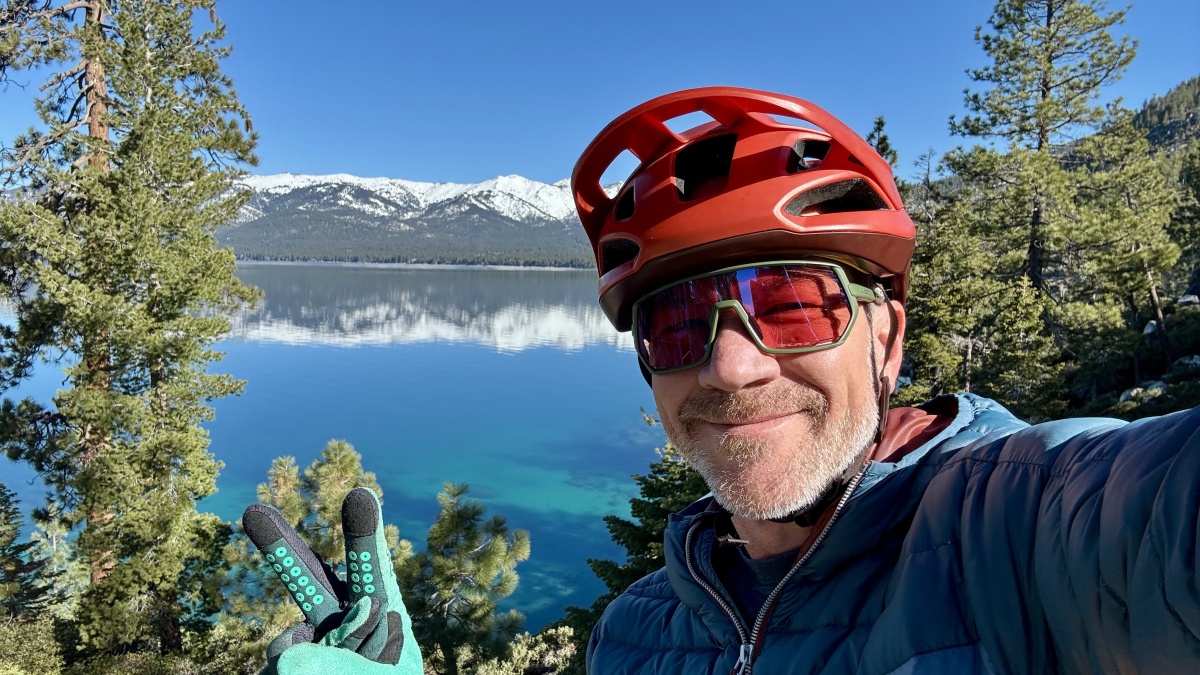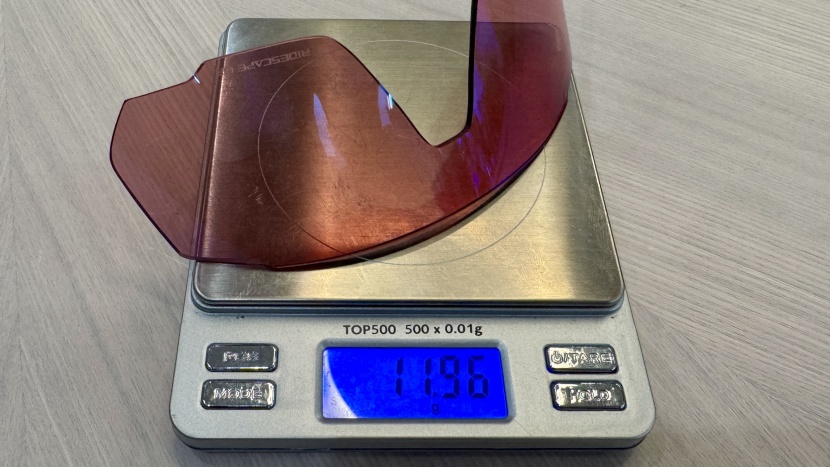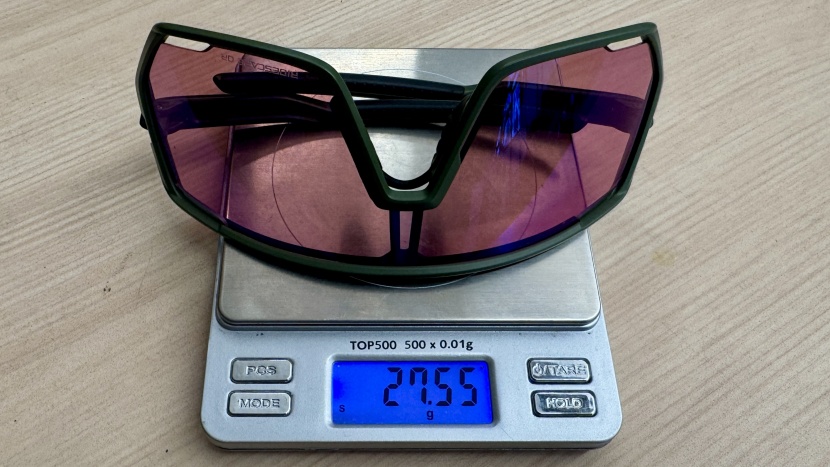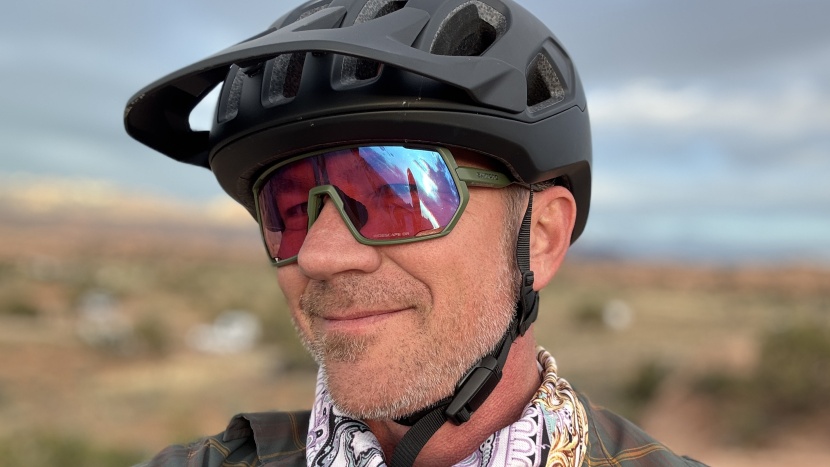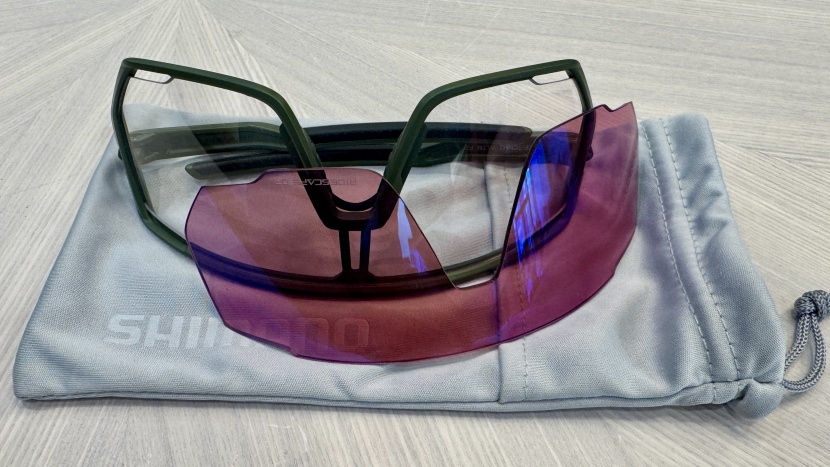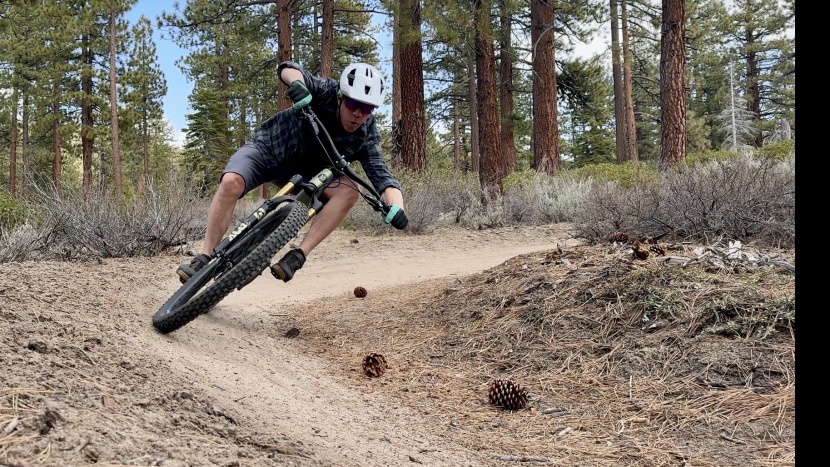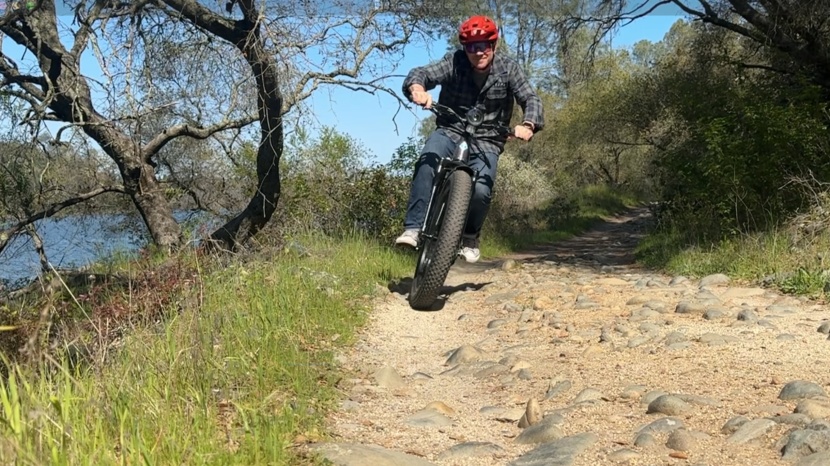
Our Verdict
Our Analysis and Test Results
The Shimano eyewear line has confusing nomenclature; to be as clear as the lenses, the model I tested is the CE-TCNM2. This is a full-frame, single-lens, lightweight piece with Shimano's Ridescape OR (off-road) lens. If you're new to mountain bike glasses, you may have noticed that all the lenses seem reddish brown or rosy in color. This is due to the colors that you're most likely to encounter while riding, and in particular, the colors and textures of the things that are most important. The lens color brightens shades of reds and browns, think, trails, tree bark, and rocks on the trail.
Lens Quality
On the trail, Shimano's Ridescape lens creates an impressive contrast and enhanced depth perception in similar colors. It might be tempting to get a do-it-all sunglasses that work on the trail and elsewhere, but mountain biking is a demanding sport, and having a specialized lens that highlights the important hues while protecting your vision is highly recommended. There are special lenses made for the demands of road cycling and gravel cycling, but these are for the rigors of mountain bike riding. I'm going to get fairly technical about the lenses, skip ahead if you just wanna know if they make you look cool. The Ridescape lenses use a lightweight polyamide substrate with a low refractive index. This means that light moves through the lenses rapidly with very minimal distortion. A high Abbe value (also known as the V-number) refers to how the lens material disperses light. As light of different wavelengths hits the lens, some of it bends as it passes through the lens material. A higher V-number provides less dispersion of those waves and better optical clarity. This eliminates chromatic aberration, or color fringes that can appear in complex light situations.
The Ridescape OR lens is optimized to “reduce glare from sun leaks when riding in and out of the shade and sharpen visual awareness so you can react more quickly to various trail surfaces.” Where the optics excel is in mixed light conditions with greys, browns, and reddish colors that you typically encounter on the trail. This isn't technology exclusive to Shimano, and they aren't alone in wanting to boost clarity and texture recognition. Riding off-road with these lenses gives you crystal clear recognition of the terrain while driving to the trailhead or hanging out at the beach, they're predictably lackluster. When I started testing these glasses, we were coming out of winter, and much of the soil I encountered was moist and dark in color. The optical clarity was exceptional, while occasional patches of snow were pink and blinding. As I rode them in the following months, the days got longer and the water content of the soil dropped; dark browns turned to tans and greys. The light lasted longer and got more intense, shadows had more contrast, and the lenses continued to impress me.
The non-polarized Ridescape OR has 35% VLT, so they might not be ideal for those with high light sensitivity. I have high light sensitivity and found the lenses near perfect in all but the brightest conditions. I felt myself squinting in bright, open desert locations and near patches of snow. The flip side of the higher VLT was evident in shadowy, low-light areas where the optics didn't diminish my visibility. 100% of UVA, UVB, and UVC rays are blocked, keeping your eyes healthy and protected.
The Technium uses a cylindrical lens construction, which essentially means they are built on a 2D axis instead of a 3D spherical axis. The Polyamide lens is 12% lighter than a typical polycarbonate lens of the same dimensions. This might not seem significant, but two fewer grams hanging off your nose for three hours is certainly welcome.
Fit and Comfort
I found the Technium to be incredibly comfortable. Weighing just 27.5 grams, the frames rest on your face without digging into your ears or the bridge of your nose. The arms feature a textured silicone coating that prevents slipping on your ears when sweaty and remains comfortable for hours during a ride. The nosepiece is made of the same silicone rubber and is reversible for a wider / narrower fit.
The overall size of the shield lens shade is quite large, which can cause issues with ventilation on some eyewear. However, the Shimano shaded lenses have cutouts that allow for some airflow. The small cutouts at the top and bottom of the lenses allow for sufficient venting, ensuring that the glasses never fogged up on us, nor did we notice any ingress of dust or debris. I found the fit and contour of the fronts of the helmets I used to be ideal, with the frames never sitting high enough to interfere with the helmet.
I have a large head (60.5cm) and a large face, and sometimes struggle to find shades that don't pinch my face or allow for airflow around the outside. I found the Shimano glasses not only to provide coverage but also to feel secure without that pitching sensation on the temples. I did however experience some poking from the ends of the arms that became more apparent as my rides got longer. This wouldn't be an issue if you could bend the ends of the arms.
Coverage
The Ridescape OR lens measures 140 x 57mm, which is wide enough to shield you from the paparazzi but still allow you some airflow. The lens provides excellent protection, and the cutouts undoubtedly help with ventilation. Sometimes large shield shades interfere with the brim of the helmet, resulting in downward pressure on the bridge of your nose, but I don't find that to be the case with any of the helmets I used them with.
Even in whippy, windy descents, my eyes stayed calm behind the lens. There was no noticeable ingress of wind or dust flying around to cause stress. I've long favored glasses without a lower rim but the way the air flows around the frames on these is near ideal.
Frame Quality
The Shimano frames and lenses are made from 45% Arkema Rilsan clear G850 Rnew, which is a transparent bio-based polyamide material. The main benefit of this material is that it has a low-carbon manufacturing process; however, we're talking about a sub-30-gram product, so don't pat yourself on the back too hard. Rilsan is made from castor oil and, as such, is 100% renewable. The material works well for applications such as injection-molded sunglasses, leaving them flexible, lightweight, and chemically resistant (think sunscreen). There are lighter materials available, but a full-frame, full-coverage sunglass weighing 27.5 grams is respectable and comfortable. The reversible silicone nose pad allows you to adjust the distance between the lens and your face.
The frame uses a support bridge above the nose pad to connect the top and bottom of the frame. This likely exists to add some structural rigidity to the eyewear, and while I was concerned that this bridge would be visible, I never noticed it while riding.
I appreciated the comfort provided by the silicone template grippers above my ears, but did find occasional interference with the arms and my helmet's retention mechanism. The ends of the arms are not maleable, so you can't bend them down to wrap your ear or outward to avoid the helmet. I used these shades with several POC helmets, two Specialized helmets, and a Leatt lid; the issue wasn't consistent with any of the helmets but occasionally required some readjusting on my part.
Field Performance
Aside from the interference I mentioned above, I would often forget that I was wearing these glasses, and I don't think there's a better endorsement of eyewear than forgetting it's on your face. Most of the other cycling sunglasses I'm using right now are half-frame models, and I prefer not having the lower frame, but I found the Shimano frame to be unobtrusive and something I only noticed when viewing a top-tube mounted screen on the new Levo. A benefit of the full frame is increased wind protection; there isn't a slippery way for wind (and dust) to sneak under the lens. A downside to the full frame is that they tend to vent less, but Shimano addressed this with the cutouts in the lenses, and I found them to resist fogging, stay cool, and keep the dust out of my eyes at all speeds.
I really liked these glasses and feel that they're well-designed and work well on my large face. I used both lenses in all light conditions. I never experienced fogging, even on a hot and sweaty 4400' climb. They have 35% variable light transmission, so those with light-sensitive eyes might not find them ideal in bright sun conditions. It's essential to note that a good cycling sunglass is unlikely to be ideal for anything else. The mountain bike-specific lens highlights objects and surfaces unique to mountain biking, so these lenses aren't even ideal for road biking. I did some road rides with them, even a few gravel rides and long drives, but technically, there are more optimal lenses for those activities.
Style
Are you here to wrestle? That's what a friend asked when I walked into lunch wearing the Ridescape OR. They look perfectly appropriate with a helmet, and I found their styling to be mild for cycling eyewear, but again, these are purpose-built shades. The frames are available in 6 colors, but only two of them had the off-road lenses when I bought them. Since I generally ride alone in the woods, I wasn't terribly concerned about what the local bears thought of my eyewear choice. There are many sunglasses out there with polarizing styles, but if form follows function for you, the style won't distract from their coverage and fit.
Case Quality
The Ridescape OR comes in a microfiber cloth bag with a separate pocket for the additional lens. The bag does a good job of protecting the lenses from scratching, but doesn't protect the glasses from being crushed like a hard case. The box that the glasses come in looks like a standard cardboard box, but it's actually a hinge-top style with a magnetic closure. So, while it's nothing fancy, I found the box to be quite useful for travel and storing the shades in my van.
Should You Buy the Shimano Technium Ridescape OR?
If you want to enjoy enhanced vision on the trails without breaking the bank, this is certainly a piece to entertain. I've been effusive about some of the eyewear I've tested over the years. The contrast with Oakley's Prizm Trail Torch lenses or the weight of the Julbo Density are some serious standouts, but here we have a well-designed pair of sunglasses that just do it all right. The fact that I forgot I was wearing these speaks volumes about their comfort and clarity. You can spend significantly more on riding glasses, but at some point (perhaps around $100), you start to see diminishing returns on your investment.
What Other Cycling Sunglasses Should You Consider?
If you want something even lighter and less obtrusive, the Julbo Density Reactiv 0-3 would be my suggestion. The Density is absolutely minimal, but still provides full coverage. If lens quality and finding definition in the trails you're riding is a top priority, check out the Smith Wildcat or Oakley Sutro Lite with some of the best optics I've ever experienced on the trail. Both will demonstrate the significant benefits of lens technology for your ride.


